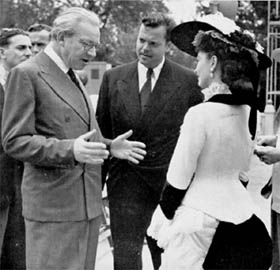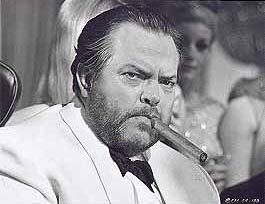|
|
 |
|
Orson
Welles, studio portrait from the early 1940s.
|
|
Orson Welles: The SIMPP Years
Excerpt from Hollywood Renegades
by J. A. Aberdeen
Orson Welles suffered from a recalcitrant image, which he claimed was thrust
upon him shortly after he joined the Society of Independent Motion Picture
Producers in the early 1940s, as his relations with RKO deteriorated. In
hindsight, many of Welles' creative and financial difficulties came from his
retreat from independence when he gave up final cut privileges in exchange for
better studio terms after Citizen Kane (1941). As he became more
dependant on studio financing, he found the carpet was repeatedly pulled out
from under him.
Welles also blamed his difficulties on his good-will tour of South America
that began in February 1942, one month after he cofounded the Society of
Independent Motion Picture Producers. RKO took control of The Magnificent
Ambersons (1942), reedited it in his absence, and forced the release of the
$1 million film that went on to lose $600,000. Then in the midst of Welles'
rumored extravagance in Brazil, RKO halted production on his unfinished South
American-themed feature It's All True. When he returned to Hollywood, his
Mercury production company was ordered off the RKO lot to make way for Sol
Lesser's Tarzan unit.
 |
|
Charlie
Chaplin and Orson Welles shown during their speaking tour in October
1942.
For more information on the infamous Carnegie Hall lecture, click
here.
|
|
Welles tried for many years to reclaim the unfinished It's All True
footage from RKO, and worked as an actor and director for other producers in
order to raise the money to purchase the film negative-which would have been his
property all along had he taken the same course as the other independent
producers.
"The basis of the whole enormous anti-Welles edifice dates exactly from
South America. When I came back from there, I didn't get a job as a director for
four years." The filmmaker claimed that his career never recovered from the
reputation of recklessness with which the studios had branded him. Furthermore,
his obsession with the unfinished It's All True kept his career from
progressing. "I tried everything," he said in his efforts to wrestle
control of the film footage from RKO. "I was near it, near it, near it. I
wasted many years of my life. If I had turned my back the way they did on it, I
would have been much better off. But I kept trying to be loyal to it. It began a
pattern of trying to finish pictures which has plagued me ever since."
 |
|
Welles
(center) visiting with Alexander Korda and Vivien Leigh on the set of
Korda's Anna Karenina (1948).
|
|
He struggled to keep Mercury Productions alive, and loaned himself out to
independent producers including David O. Selznick (Jane Eyre, 1944),
Sam
Spiegel (The Stranger, 1946), Edward Small (Black Magic, 1949),
and Alexander Korda (The Third Man, 1949).
Orson Welles has become known as one of the surrogate fathers of the modern
anti-Hollywood movement. But even he suggested that the old studio system had at
least provided symbiosis for filmmakers like himself. “Hollywood died on me as
soon as I got there,” Welles said in 1970. “I wish to God I'd gone there
sooner. It was the rise of the independents that was my ruin as a director. The
old studio bosses - Jack Warner, Sam Goldwyn, Darryl
Zanuck, Harry Cohn - were
all friends, or friendly enemies I knew how to deal with. They offered me work.
. . . I was in great shape with those boys. The minute the independents got in,
I never directed another American picture except by accident. . . . I was a
maverick, but the studios understood what that meant, and if there was a fight,
we both enjoyed it. With an annual output of 40 pictures per studio, there would
probably be room for one Orson Welles picture. But an independent is a fellow
whose work is centered around his own particular gifts. In that setup, there is
no place for me.” Many of the SIMPP producers who clung to the past could not
manage in the new Hollywood that they helped bring about.
 |
|
Welles
during a later movie appearance in Casino Royal (1967).
|
|
In 1948 Orson Welles quit SIMPP as he prepared for an extended visit to
Europe to find financing for his next films. He ended up an overseas resident
for nine years before he returned to the United States to direct his final
important Hollywood film, Touch of Evil (1958). Welles, the last
surviving SIMPP founder, died from a heart attack October 10, 1985.
SOURCES:
"The basis of the whole": Welles and Bogdanovich, This
Is Orson Welles, p. 134.
"I tried everything": Les Films Balenciaga and
Paramount Pictures, It's All True, (video documentary), 1993. Also see
Welles and Bogdanovich, pp. 164-165.
Orson Welles and Mercury: "Welles Brazilian Film 1st
Under Whitney Plan," DV, January 28, 1942, p. 6; "'All True'
May Be Free Film Orson Welles Owes RKO Studio," DV, February 2,
1942, p. 7; Thomas F. Brady, "More on Welles vs. RKO," NYT,
July 26, 1942, sec. II, p. 3.
"Hollywood died on me": Welles and Bogdanovich, p.
204.
The Chaplin-Welles lecture tour: "Artists Front to Win
the War," advertisement for the Carnegie Hall "Win the War
Meeting" on October 16, 1942.
“Hollywood died on me”: Welles and Bogdanovich, This Is
Orson Welles, p. 204.
See Bibliography.
|